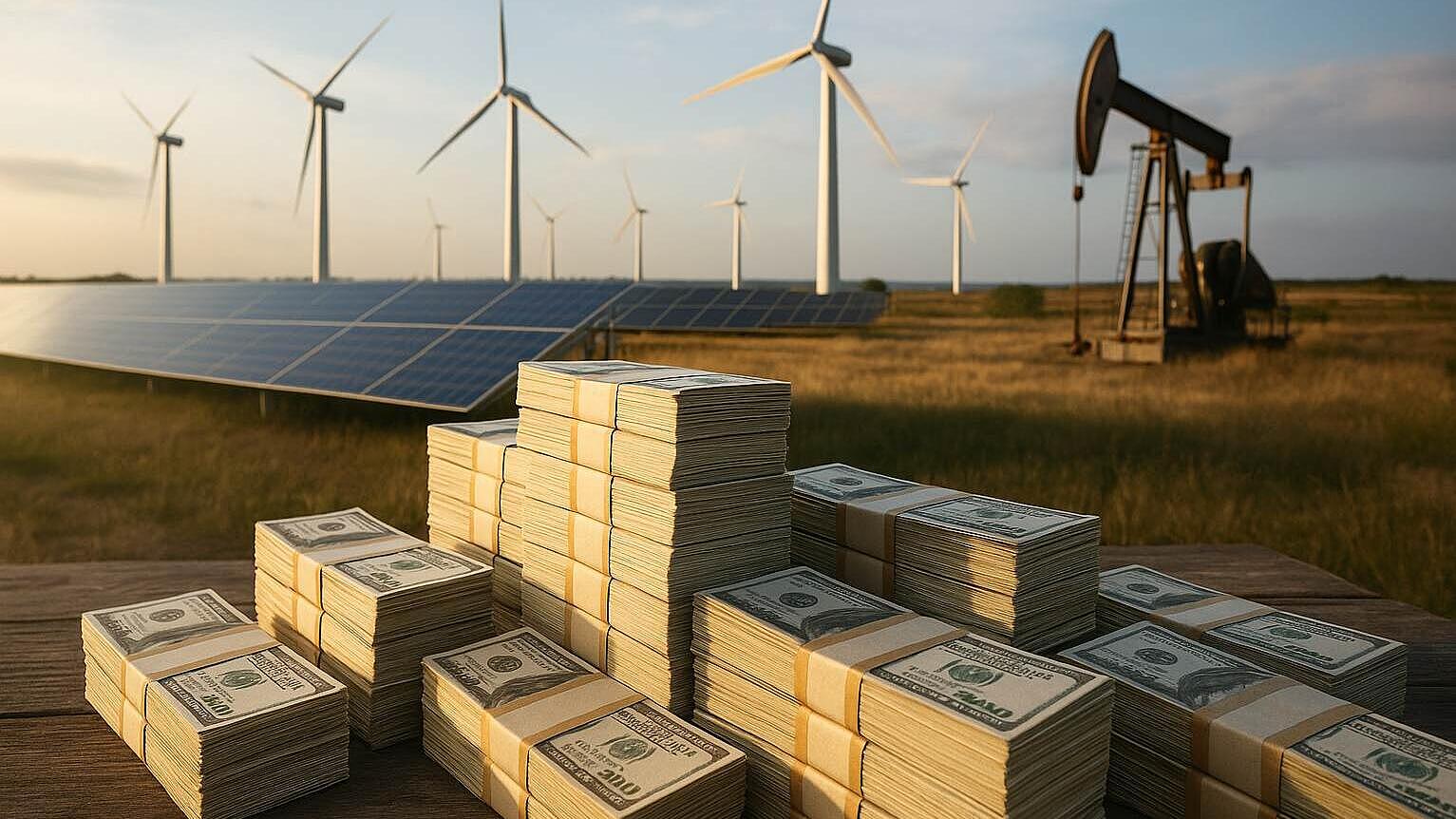 Finance & Economics
Finance & EconomicsHow Global Energy Investment Transformed from 2019 to 2025
Summary
Between 2019 and 2025, the world saw a substantial shift in energy investment trends, with total spending surging from USD 1.8 trillion to USD 3.3 trillion. Clean energy received more than twice the funds compared to fossil fuels by 2025, driven by various factors including post-pandemic recovery initiatives, technological advancements, and geopolitical developments. China's strategy to diminish oil and gas imports, Europe's response to the Ukraine crisis, and U.S. policies promoting clean technology contributed to this change.
By 2025, solar photovoltaics (PV) attracted the largest share of investment, reaching USD 450 billion, as costs significantly dropped due to economies of scale, particularly exploited by Chinese manufacturers. This led to a widespread adoption of distributed solar in emerging markets, such as Pakistan, where it provided an alternative to unreliable national grids.
Investment in clean energy nearly aligned with the IEA's Sustainable Development Scenario, reaching around two-thirds of total energy investment. However, grid investment lagged, resulting in bottlenecks for renewable energy deployment and highlighting the pressure on infrastructure due to increased electrification of various sectors like transport and data centers.
In advanced economies, an unexpected demand for firm baseload power arose, renewing interest in nuclear energy and natural gas to support new demands, such as those from AI and data centers.
Innovation and investments also grew in energy storage, with investments in batteries reaching USD 66 billion by 2025. Despite advancements, the energy transition faced challenges such as supply chain constraints for critical minerals, underscoring the complex interactions within technology ecosystems.
There were also disparities in clean energy deployment, with Africa receiving a disproportionate share of investment relative to its population. This highlighted the persisting barriers such as financing costs, currency risks, and institutional challenges that technology cost reductions alone cannot overcome.
Finally, the decline in fossil fuel investments, particularly in oil, reflected both climate policies and market dynamics, with U.S. shale investments falling. The period from 2019 to 2025 emphasized the importance of integrating policy, finance, technology, and societal behaviour to further progress in clean energy transitions. The IEA recognized the need to double renewable investments, increase grid spending, and establish frameworks for distributed energy to meet 2030 climate goals.
Open full article
How Global Energy Investment Transformed from 2019 to 2025
In 2019, as delegates at energy summits debated the pace of the clean energy transition, a quiet tension underpinned global investment trends. The world invested over USD 1.8 trillion that year, but with a clear misalignment between actual spending patterns and what was needed to achieve the Paris Agreement and Sustainable Development Goals. Fast forward to 2025: energy investment has surged to USD 3.3 trillion, with clean energy commanding more than twice the capital allocated to fossil fuels. What changed? And what ripple effects, intended or otherwise, have steered the energy sector into its current dynamic state?
A Shifting Investment Landscape
In 2019, the IEA noted that low-carbon investments accounted for around 35% of total energy investment, with much of the capital still flowing towards oil, gas, and coal. Power sector investment led over fuel supply, largely due to China and India’s drive for electrification, yet the pace of reallocation towards renewables fell short of scenarios aligned with climate goals.
By 2025, the picture is starkly different. Clean energy investment has doubled over five years, powered by post-pandemic recovery packages, technology advances, and geopolitical shifts. In particular, China’s drive to reduce oil and gas import dependence, Europe’s acceleration after the Ukraine crisis, and U.S. industrial policy aimed at clean tech leadership have fueled this surge. Investment in solar PV alone reached USD 450 billion in 2025, making it the largest single component of global energy investment.
A key non-linear effect has been the rapid cost decline of clean technologies. Solar module prices plummeted, as seen in the 2025 report, with Chinese manufacturers leveraging economies of scale to dominate global markets. This drove distributed solar booms in emerging economies like Pakistan, where 19 GW of imports in 2024 enabled consumers to bypass faltering national grids.
From Policy Projections to Reality
In 2019, the IEA’s Sustainable Development Scenario (SDS) highlighted that achieving climate targets would require low-carbon investments to rise to 65% of the total by 2030. Grid spending, too, needed to climb to enable massive renewables integration. At that time, few countries had concrete plans to deliver this step change.
By 2025, we see mixed results. The clean share of energy investment has climbed to around two-thirds, broadly tracking the SDS pathway. But grid investment, despite surpassing USD 400 billion in 2025, still lags behind generation spending, creating bottlenecks that slow renewables deployment. Moreover, the rush to electrify end uses — from EVs to data centres — has outpaced grid upgrades, underscoring how interconnected these sectors have become.
Unexpectedly, the rise of AI and data centres triggered demand for firm baseload power, reviving interest in nuclear and even natural gas in advanced economies. The U.S. and Middle East saw a resurgence in gas-fired plant investments to support this load, with small modular reactors (SMRs) emerging as a serious contender for future supply.
Innovation, Risks and Ecosystem Dynamics
Beyond the headline numbers, the interplay of policies, markets, and technologies produced unforeseen dynamics. In 2019, IEA called for innovative financing solutions to unlock end-user efficiency and distributed energy. By 2025, distributed solar in EMDEs became a grassroots phenomenon, driven less by policy and more by the convergence of cost declines, grid failures, and consumer action. Pakistan’s solar boom — an unanticipated outcome — reshaped power sector economics, eroding utility revenues and complicating efforts to fund national grids.
Similarly, battery storage, barely visible in 2019 investment tallies, grew to nearly USD 66 billion by 2025. The technology evolved from niche to essential, supporting renewables integration, grid balancing, and even microgrids. Yet, supply chain constraints — especially in critical minerals — introduced new vulnerabilities. This demonstrated how ecosystem effects, such as price signals in minerals, can ripple across technology markets.
Towards the Energy Future
While clean energy investments have scaled dramatically, gaps remain. The 2025 reports show that clean power deployment is not uniformly spread: Africa, despite housing 20% of global population, secures only 2% of clean energy investment. Financing costs, currency risks, and institutional barriers limit progress, highlighting that technology cost declines alone can’t solve systemic inequities.
At the same time, fossil fuel investments — particularly in oil — are declining in absolute terms, reflecting not only climate policies but also market realities. U.S. shale, once a growth engine, saw upstream investment fall almost 10% in 2025, as market discipline and consolidation took hold.
Charting the Course Ahead
For students and young professionals entering the energy field, the lessons of 2019–2025 are clear: policy, finance, technology and societal behaviour are tightly interwoven. Success in clean energy transitions requires not just innovation but systems thinking. As the IEA notes, meeting 2030 targets will depend on doubling renewable investments again, scaling grid spending, and creating robust frameworks for distributed solutions. The coming years offer both challenge and opportunity — and it is up to the next generation to build on this progress and drive the world towards a sustainable and equitable energy future.
Source: www.iea.org/reports/world-energy-investment-2025



